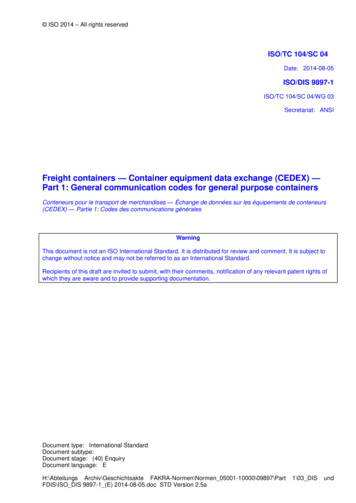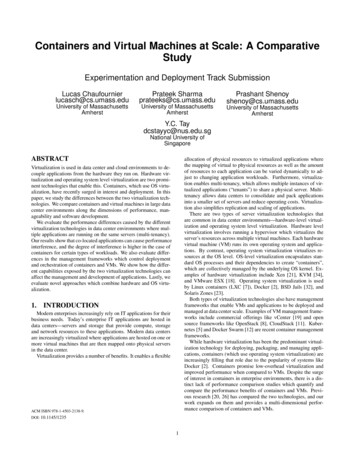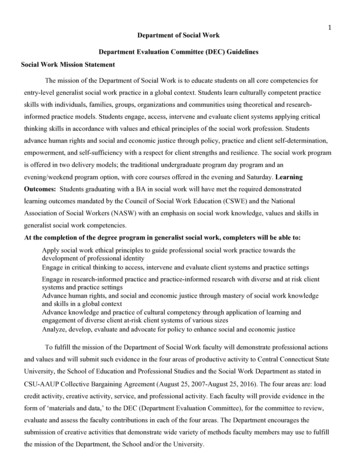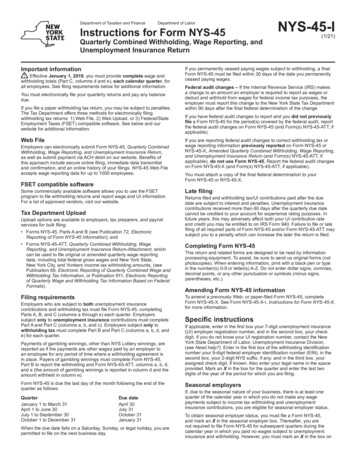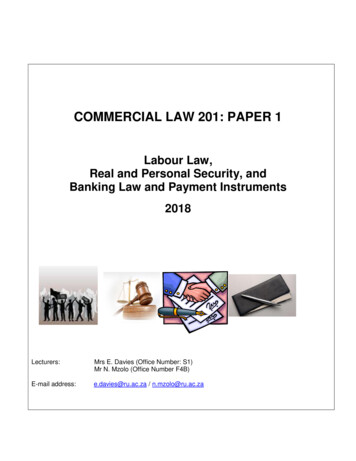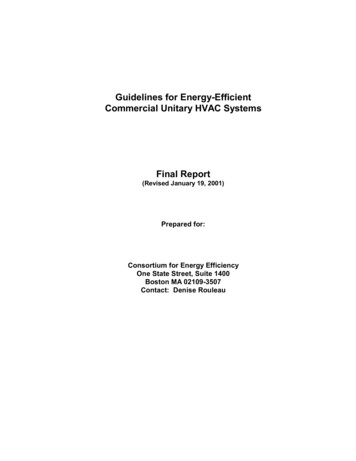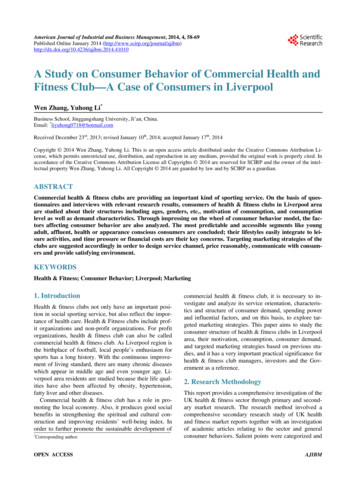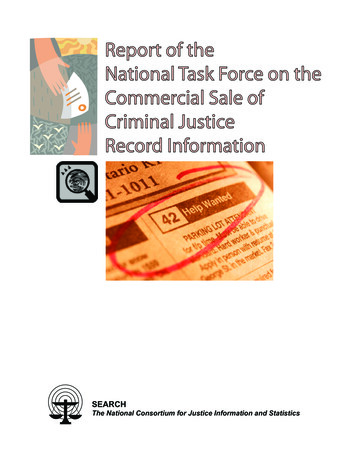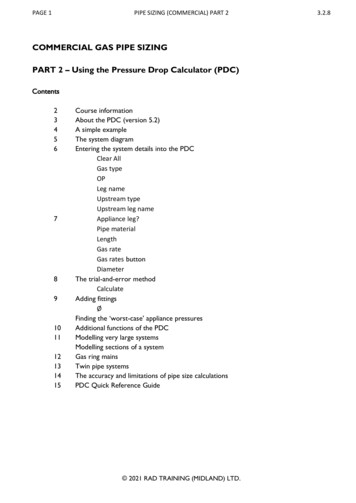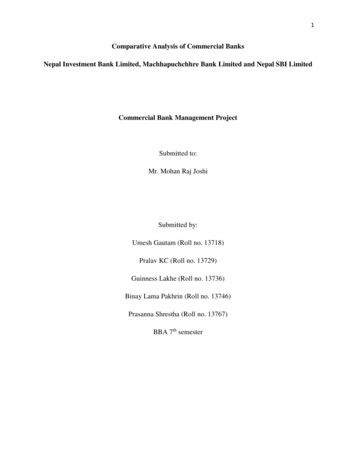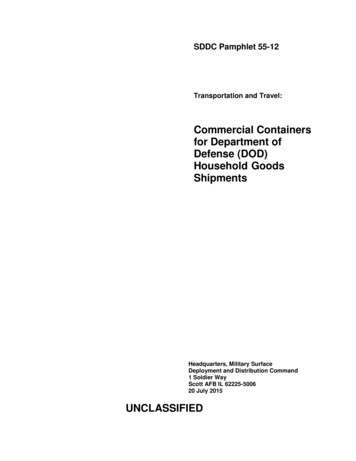
Transcription
SDDC Pamphlet 55-12Transportation and Travel:Commercial Containersfor Department ofDefense (DOD)Household GoodsShipmentsHeadquarters, Military SurfaceDeployment and Distribution Command1 Soldier WayScott AFB IL 62225-500620 July 2015UNCLASSIFIED
SUMMARY of CHANGESDDC Pam 55-12Commercial Containers for Department of Defense Household Goods ShipmentsThis administrative revision, dated 20 July 2015 –o Revises format of command publication.o Adds requirement for heat treatment marking.o Clarifies container testing should be conducted to a modified Distribution Cycle 18,Assurance Level II within ASTM-D-4169.o Adds test requirements for temperature and humidity sensitive containers.o Removes Code 3 type of container service.o Adds the use of "best commercial practice" containers for Code 2 shipments.o Inserts paragraph on heat treatment marks.o Adds the use of Portable Moving and Storage Containers for Code 2 shipments.o Revises Chapter 3, Specific Test Requirements for Containers.
FORWARDThis pamphlet is issued to provide information pertaining to commercially owned shippingcontainers used for the movement and storage of Department of Defense (DOD) sponsoredpersonal property shipments.This pamphlet does not apply to Government-owned shipping containers. Information regardingthese containers may be found in the most recent issue of American Society for Testing andMaterials (ASTM), ASTM-D-4169, Standard Practice for Performance Testing of ShippingContainers and Systems.
This page intentionally left blank.
*SDDC Pam 55-12DEPARTMENT OF THE ARMYHEADQUARTERS, MILITARY SURFACE DEPLOYMENT AND DISTRIBUTION COMMAND1 SOLDIER WAY, SCOTT AIR FORCE BASE IL 62225-5006SDDC PAMPHLETNO.55-1220 July 2015Transportation and TravelCOMMERCIAL CONTAINERS FOR DEPARTMENT OF DEFENSE (DOD) HOUSEHOLDGOODS SHIPMENTSParagraphPageChapter 1. GeneralPurpose. 1-1.1Scope. 1-2.1Responsibilities. 1-3.1DOD Container Policy. 1-4.2Summary. 1-5.2Chapter 2. Criteria for Use of ContainersGeneral. 2-1.2Code of Service. 2-2.2Container Markings. 2-3.3Wooden Overflow Boxes. 2-4.3Container Closure, Sealing and Reinforcement. 2-5.3Stacking Containers. 2-6.4Shipment Markings. 2-7.4Transportation Service Provider (TSP) Container Markings.2-8.4Heat Treatment Marking. 2-9.4Variance in Construction Materials. 2-10.4Fiber Containers. 2-11.5SDDC-Approved Fiberboard Containers. 2-12.5Portable Moving and Storage Containers. 2-13.5Chapter 3. Specific Testing Requirements for ContainersRequirements. 3-1.6Test Facility. 3-2.7Test Specimen. 3-3.7Conditioning. 3-4.7Test Sequence. 3-5.7Acceptance Criteria.3-6.9Report. 3-7.9*This pamphlet supersedes SDDC Pam 55-12, dated May 2004
SDDC Pam 55-12Chapter 4. Container InspectionsContainer Inspection Report. 4-1.10Inspection Checklist. 4-2.10Serviceable/Unserviceable Containers. 4-3.11APPENDIXA. References. 12B. SDDC Form 364, Container Inspection Report. 13GLOSSARY . 14ii
SDDC Pam 55-12Chapter 1General1-1. Purpose. To provide ready information concerning the approval and use of commerciallyowned containers approved by the Military Surface Deployment and Distribution Command(SDDC) for DOD-sponsored personal property shipments. Information contained herein doesnot apply to Government-owned shipping containers. Information regarding the requirementsfor these containers may be found in the most recent issue of American Society for Testing andMaterials (ASTM), ASTM-D-4169, Standard Practice for Performance Testing of ShippingContainers and Systems. NOTE: The containers described in this pamphlet are not applicable tothe transportation of privately owned vehicles.1-2. Scope. Chapter 2 provides criteria for use of containers; chapter 3 provides selectedreferences; chapter 4 provides container inspection procedures and SDDC Form 356, ContainerInspection Report; and a list of commercially-owned Household Goods Containers approved bySDDC. (See List of Approved Commercially-Owned Household Goods Containers.)1-3. Responsibilities.a. SDDC, Transportation Engineering Agency (TEA) will:(1) Approve all containers used for international shipments.(2) Update list of approved containers.(3) Monitor the container program on a worldwide basis.b. Carrier/container manufacturers will:(1) Furnish test reports from an independent testing laboratory for containers whenrequesting SDDC container approval. Test container to a modified Distribution Cycle 18,Assurance Level II in accordance with the most recent issue of ASTM-D-4169.(2) Use SDDC-approved containers for all containerized shipments of personal property.c. Personal Property Shipping Offices (PPSOs) will:(1) Assure carriers use only SDDC-approved containers for international shipments.Containers used for CONUS or OCONUS shipments must be inspected to ensure they are insound condition (no holes, not deteriorated, properly caulked).(2) Prohibit the use of unapproved or unsatisfactory containers.(3) Inspect international shipments containers for SDDC approval number, generalcondition and ensure containers for CONUS or OCONUS shipments have proper markings.Inbound shipments with container deficiencies will be reported to origin PPSO.1
SDDC Pam 55-12d. SDDC Military Ocean Terminals will monitor containers transiting the terminals and reportuse of unapproved or unsatisfactory containers to origin PPSO.e. Air Mobility Command terminals will report the use of unserviceable containers to theorigin shipping office.1-4. DOD Container Policy. DOD does not restrict the carriers as to types of material, length,width or height of commercially developed containers. DOD does require, however, that allcontainers be constructed in such a manner as to satisfy the testing requirements of ASTM-D4169, modified Distribution Cycle 18, Assurance Level II (see chapter 3 for more details).1-5. Summary. This pamphlet applies for the use of commercially-owned personal propertycontainers, on a worldwide basis.Chapter 2Criteria for Use of Containers2-1. General. Carriers will use only SDDC-approved containers for international shipmentswhich are in sound condition. Carriers will ensure “best commercial practice containers” usedfor domestic, door-to-door container movements are in sound condition. The PPSO may (undercertain conditions) authorize use of Government-owned containers, ASTM-D-4169, with areduced cost to the Government in accordance with appropriate tariffs/tenders or require use if awaiver authorization has been granted by SDDC. Under the waiver provision, reduced cost tothe Government does not apply. When approved, the Government-owned containers must be insound condition and free from visible defects.2-2. Code of Service.a. Approved containers must be used for the following codes or types of service:(1) Code 2 - Domestic, door-to-door container movement.(2) Code 4 - International, door-to-door container movement.(3) Code 5 - International, door-to-door container surface, Government movement.(4) Code T – International, door-to-door air movement.b. SDDC-approved containers are authorized for use on containerized shipments when thismode of service is selected by the PPSO. When this service is ordered and commercialcontainers are used, the container requirements outlined in this pamphlet will apply.c. SDDC’s Personal Property (PP) directorate authorized the use of “best commercialpractice” containers for CONUS moves (Code 2 – Domestic, door-to-door container movementand Code D shipments, where the Transportation Service Provider (TSP) elects to containerize)2
SDDC Pam 55-12in the SDDC Domestic 400NG Tariff 2011, change 1, updated 28 January 2011. Any such useof Code 2 containers will be subject to the rules and requirements in the Defense TransportationRegulation (DTR) Part IV, the SDDC Domestic 400NG Tariff, and other guidance issued bySDDC PP. Code 2 containers are not subject to the container test requirements outlined inchapter 3 of this pamphlet or marking the SDDC-approved containers defined in paragraph 2-3.2-3. Container Markings. All SDDC-approved containers used for the movement of DODsponsored cargo will be branded by the container manufacturer with the approval number at thetop right-hand corner of both side panels and the non-removable end panel with 1-1/2-inchnumerals, such as "SDDC-000A.” Other container markings will be in accordance with the DTRPart IV.2-4. Wooden Overflow Boxes. Overflow boxes will be constructed in accordance with ASTMD-6251, Standard Specification for Wood-Cleated Panelboard Shipping Boxes, Style A or B, andwill be caulked during assembly. Overflow boxes do not require an SDDC approval number.2-5. Container Closure Sealing and Reinforcement. Containers that require a sealant/caulkingmaterial applied to the joints and door to ensure water-tightness will be sealed/caulked prior tocontainerization of each shipment. Usage may cause the caulking to become dry, brittle, ordislocated from the container joints and seams. Re-caulking, on an as needed basis, is requiredto maintain the water-tightness of the container. Testing has determined that the most effectivemethod to seal/waterproof a container is to caulk all seams with the exception of the horizontalfloor seams. This should be done during the initial assembly process. When re-caulking isnecessary to ensure the water-tightness of the container, re-caulking on the inside of thecontainer seams/joints is acceptable. Doors will be caulked on the inside joint before nailing orbolting and not on the outside container seams. Caulking material must be applied to all patchedand repaired areas of the container. Closure of the container must be performed in accordancewith the guidelines indicated in the container bill of materials contained herein or othercommercially accepted methods.a. It is recommended that containers be reinforced with steel banding to prevent pilferage.Banding should be steel strapping a minimum of 3/4 of an inch in width. Two bands should beplaced vertically approximately 1 to 6 inches from each container end and one band placedhorizontally at the container center. These procedures are suggested for all containers used forDOD-sponsored cargo.b. Overflow boxes will be caulked during the assembly process and banded in accordancewith the requirements outlined in ASTM-D-6251.c. Prior to use of vault-type containers (containers with one or multiple hinged doors), inspectand replace the gasket, weather stripping, or other material used for providing the seal behind thedoors if the material looks worn or damaged. After all contents are placed in the container andbefore transport of the vault-type containers, apply tamper‐evident security seal to vault door.Avoid use of paper security seal on vault‐type containers. Fixed length tamper‐evident securityseals used on containers or trucks constructed typically of metal or plastic can be use provided3
SDDC Pam 55-12they are weather resistant and withstand temperatures of 120 F to ‐20 F. Any brand seal that canprovide the performance stated in the previous sentence is acceptable for use.2-6. Stacking Containers. Containers are tested in accordance with ASTM-D-4169, StandardPractice for Performance Testing of Shipping Containers and Systems, Schedule B – WarehouseStacking. Containers may be double- or triple-stacked depending on size, total gross weight andcondition. Limiting factors would be size of the warehouse where containers are stacked andtype of equipment available for stacking the containers.2-7. Shipment Markings. Individual shipment markings will be stenciled on two surfaces (oneside and one end panel) of each container. Marking will be done in accordance with therequirements of the DTR Part IV, or other applicable specification as ordered by the PPSO.2-8. TSP Container Marking. Carriers are encouraged to identify their containers by assigning aserialized number or other identification code to each approved container. It is recommendedthat this number be branded or stenciled on the container to assist in the overall identification ofthe shipment.2-9. Heat Treatment Marking. All container for Code 4, 5, and T shipments that use woodlumber in their design will be constructed from wood certified by an accredited agencyrecognized by the American Lumber Standard Committee (ALSC). The certification attests thatthe wood has been heat treated to a core temperature of 56 C and held for 30 minutes.Containers will be permanently and durably marked with the approved international symbol forcompliant wood packaging material and meet the other marking requirements specified by theALSC Wood Packaging Material Policy. The container will bear at least one of these marks inan area conspicuous to the viewer (mark cannot be on the top or bottom of the container). TheInternational Standards for Phytosanitary Measures Publication 15 specifically excludesmanufactured wood-based products such as plywood as material that requires heat treatment anda heat treatment mark. Only the lumber components of wood household containers are requiredto be heat treated.2-10. Variances in Construction Materials.a. Recent advancements in the manufacturing process of construction and industrial grades ofplywood have resulted in the manufacture of slightly thinner panels. This new manufacturingtechnique has caused a slight decrease in the strength and tare weight characteristics ofcontainers used in the transportation of personal property. These variances are consideredminimal and if containers were to be retested, they generally would continue to pass the testrequirements. However, these variances do present a difference in actual specifications and billof materials originally approved. In some instances, upon inspection by quality controlpersonnel, such containers have been rejected because of not meeting the specifications outlinedin this pamphlet.b. To alleviate this problem and provide a system or method for inspectors to have an easilyaccessible identifier for containers manufactured with the new thinner and lighter panels, a codehas been devised to identify these containers from originally approved containers. All containers4
SDDC Pam 55-12constructed with the new thinner material will be branded with an "X" after the SDDC approvalnumber (example: SDDC000(X)), as identified in paragraph 2-3.2-11. Fiberboard Containers. Carriers may use corrugated fiberboard containers for thecontainerization of overflow and oversize articles or to containerize small personal propertyshipments. When fiberboard containers are used they must, as a minimum, meet therequirements of Specification ASTM-D-5168, Standard Practice for Fabrication and Closure ofTriple Corrugated Fiberboard Containers. Fiberboard containers which exceed a gross of 15cubic feet and 300 pounds must be secured to a four-way entry wooden pallet. Unlessspecifically approved by SDDC, ASTM-D-5168 fiberboard containers will not exceed 96 cubicfeet.a. After the container has been packed, it will be sealed by having all seams, corners, andjoints taped with a minimum 2-inch wide waterproof tape. The tape applied to the manufacturersjoint will cover the joint but not extend over the corners of the box onto the adjacent panels.b. After sealing, the container will be reinforced with a minimum of 3/4-inch width steel ornonmetallic strapping. The banding will be tensioned sufficiently to effect adequate closurewithout damaging the fiberboard. The container will be banded both vertically and horizontally.One band will be laced vertically at each end of each side encircling the top, sides, and bottom.When the distance between the vertical bands is greater than 18 inches, an additional band orbands will be required to provide support. One horizontal band is also required at the centerpoint of the container encircling the sides and ends.c. Individual shipment markings will be stenciled on two surfaces (one side and one endpanel) of each fiberboard container. Markings will be in accordance with the requirements of theDTR Part IV or other applicable specifications as ordered by the PPSO. In addition, wheneverthe container's contents include fragile or delicate items, the container must be marked "THISEND UP" on both sides and ends. Each container will bear a boxmaker's certificate whichcertifies that the container meets the requirements of Specification ASTM-D-5168 or A-A-2876,Commercial Item Description, Boxes Shipping Corrugated Fiberboard, High Strength WeatherResistant, Double Wall. The boxmaker's certificate will contain name of manufacturer, burstingstrength, minimum combined weight facings, size limit, gross weight, and information indicatingtype of carton (single wall, double wall, etc.). The certificate may be round or rectangular and isusually located on the bottom panel or bottom outer flap. In addition, all containers in excess of15 cubic feet will be marked with the total cubic feet based on the outside dimensions. Thesemarkings will be placed in a corner of one panel or other appropriate area which will ensurevisibility when the box is fully assembled.2-12. SDDC-Approved Fiberboard Containe
c. SDDC’s Personal Property (PP) directorate authorized the use of “best commercial practice” containers for CONUS moves (Code 2 – Domestic, door-to-door container movement and Code D shipments, where the Transpor
